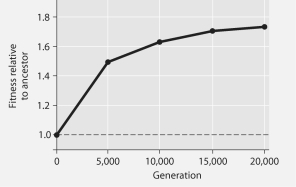Multiple Choice
The following questions refer to Figure 27.1 below, which is the same as Figure 27.10 in the textbook.
In this 8-year experiment, 12 populations of E. coli, each begun from a single cell, were grown in low-glucose conditions for 20,000 generations. Each culture was introduced to fresh growth medium every 24 hours. Occasionally, samples were removed from the populations, and their fitness in low-glucose conditions was tested against that of members sampled from the ancestral (common ancestor) E. coli population.

Figure 27.1
-E. coli cells typically make most of their ATP by metabolizing glucose. Under the conditions of this experiment, what should be True of E. coli's generation time (especially early in the course of the experiment, but less so later on) ?
A) Generation time should be the same as in the typical environment.
B) Generation time should be faster than in the typical environment.
C) Generation time should be slower than in the typical environment.
D) It is theoretically impossible to make any predictions about generation time, under these conditions.
Correct Answer:

Verified
Correct Answer:
Verified
Q14: If archaeans are more closely related to
Q21: Penicillin is an antibiotic that inhibits enzymes
Q22: Figure 27.2 depicts changes to the amount
Q23: Which of the following features of prokaryotic
Q26: The following questions refer to structures found
Q27: The following questions refer to Figure 27.1
Q29: If a bacterium regenerates from an endospore
Q35: Figure 27.2 depicts changes to the amount
Q70: Genetic variation in bacterial populations cannot result
Q77: Which two structures play direct roles in